Hospitality & Tourism: Interrelationships, Integration Analysis & Plan
VerifiedAdded on 2024/05/29
|19
|4645
|281
Report
AI Summary
This report provides a comprehensive analysis of the hospitality industry's crucial interrelationships with the broader travel and tourism sector, highlighting its role in accommodation, event management, and visitor attractions. It examines the implications of integration, including branding, market control, and globalization, using examples like Marriott's acquisition of Starwood. The report also discusses vertical and horizontal integration, their advantages and disadvantages, and their effects on hospitality businesses. Furthermore, it includes a detailed rationale and operational plan for a new hospitality business, focusing on target market justification and organizational structure with human resource allocation. Desklib is a valuable platform for students seeking further study resources and solved assignments.
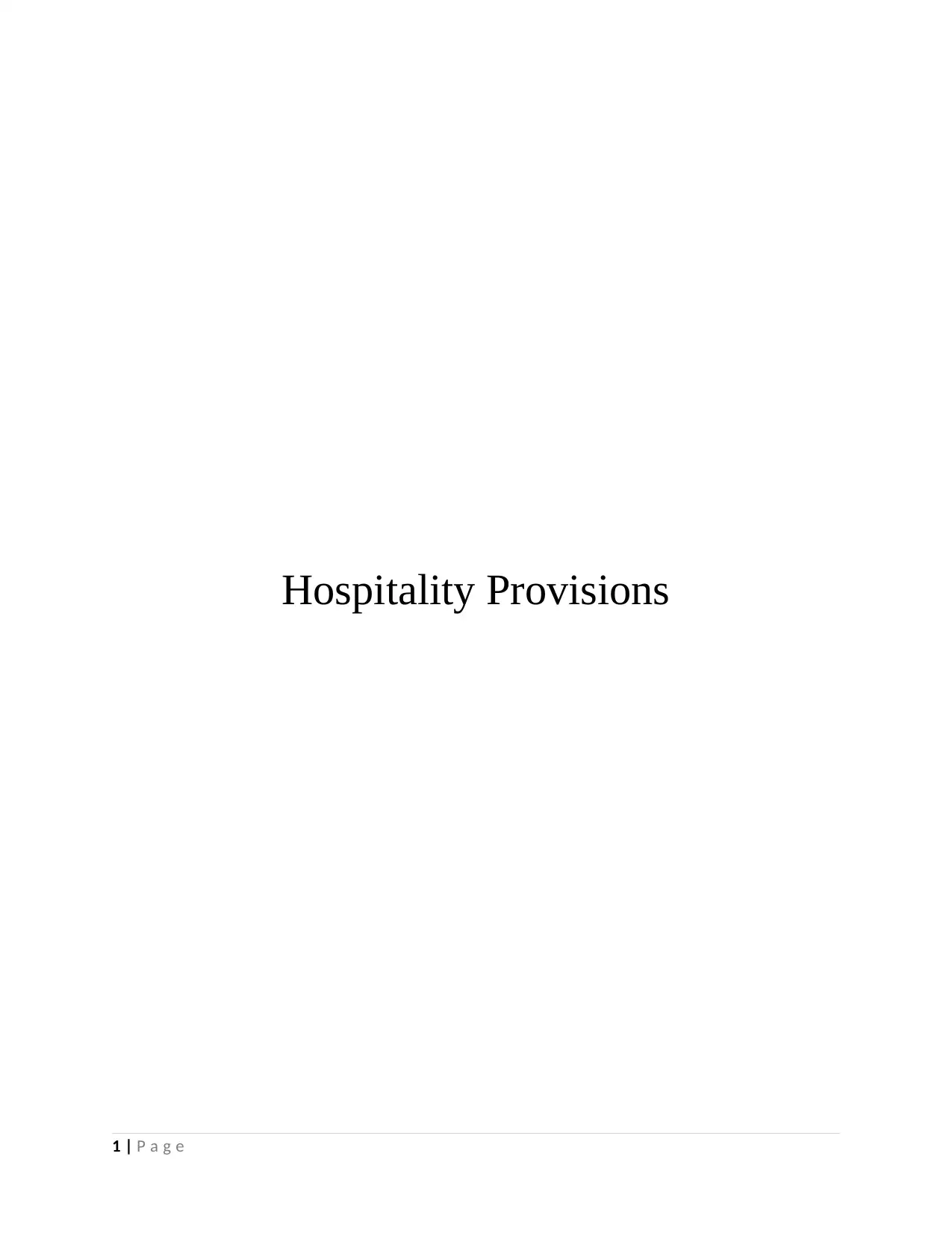
Hospitality Provisions
1 | P a g e
1 | P a g e
Paraphrase This Document
Need a fresh take? Get an instant paraphrase of this document with our AI Paraphraser
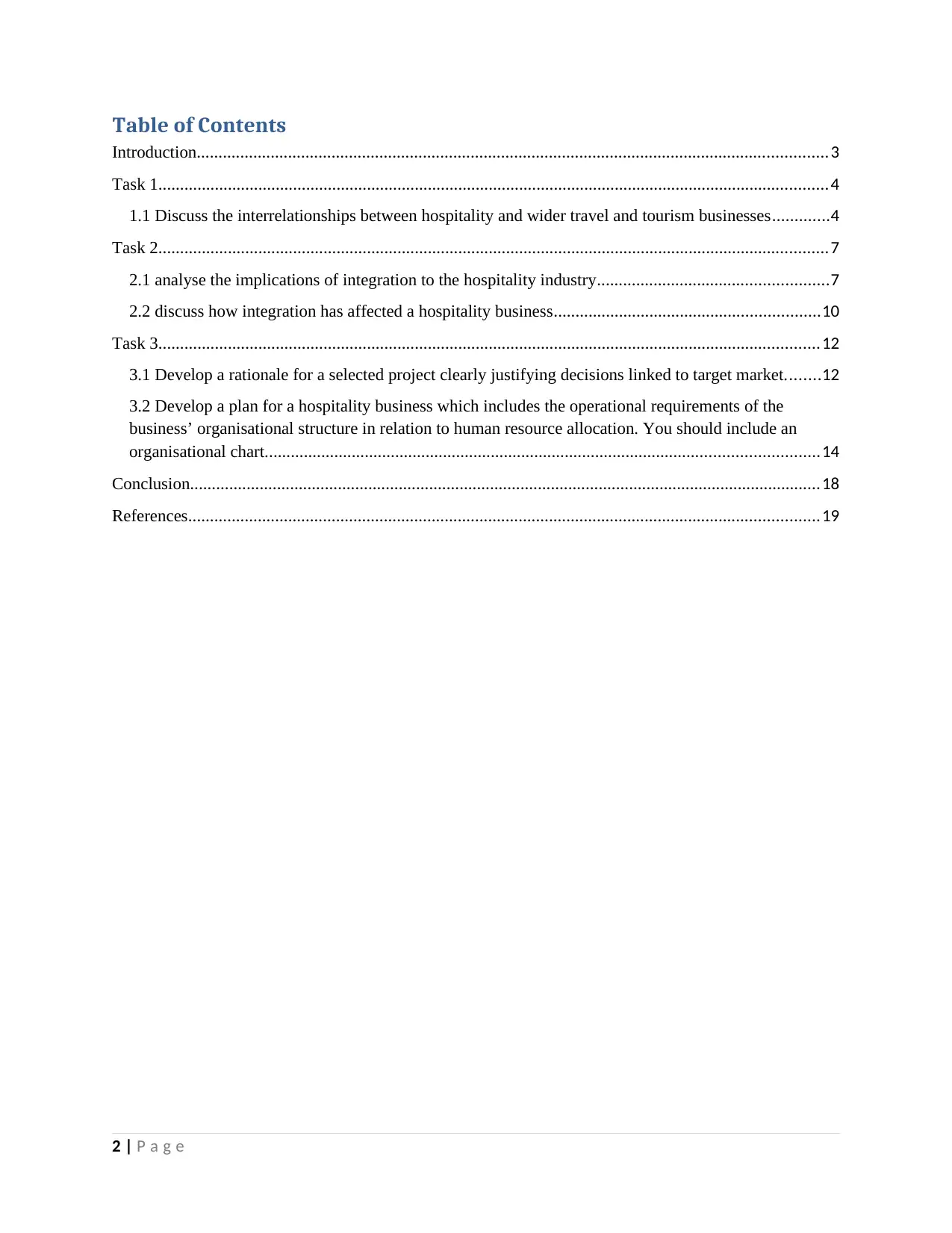
Table of Contents
Introduction.................................................................................................................................................3
Task 1..........................................................................................................................................................4
1.1 Discuss the interrelationships between hospitality and wider travel and tourism businesses.............4
Task 2..........................................................................................................................................................7
2.1 analyse the implications of integration to the hospitality industry.....................................................7
2.2 discuss how integration has affected a hospitality business.............................................................10
Task 3........................................................................................................................................................12
3.1 Develop a rationale for a selected project clearly justifying decisions linked to target market........12
3.2 Develop a plan for a hospitality business which includes the operational requirements of the
business’ organisational structure in relation to human resource allocation. You should include an
organisational chart...............................................................................................................................14
Conclusion.................................................................................................................................................18
References.................................................................................................................................................19
2 | P a g e
Introduction.................................................................................................................................................3
Task 1..........................................................................................................................................................4
1.1 Discuss the interrelationships between hospitality and wider travel and tourism businesses.............4
Task 2..........................................................................................................................................................7
2.1 analyse the implications of integration to the hospitality industry.....................................................7
2.2 discuss how integration has affected a hospitality business.............................................................10
Task 3........................................................................................................................................................12
3.1 Develop a rationale for a selected project clearly justifying decisions linked to target market........12
3.2 Develop a plan for a hospitality business which includes the operational requirements of the
business’ organisational structure in relation to human resource allocation. You should include an
organisational chart...............................................................................................................................14
Conclusion.................................................................................................................................................18
References.................................................................................................................................................19
2 | P a g e
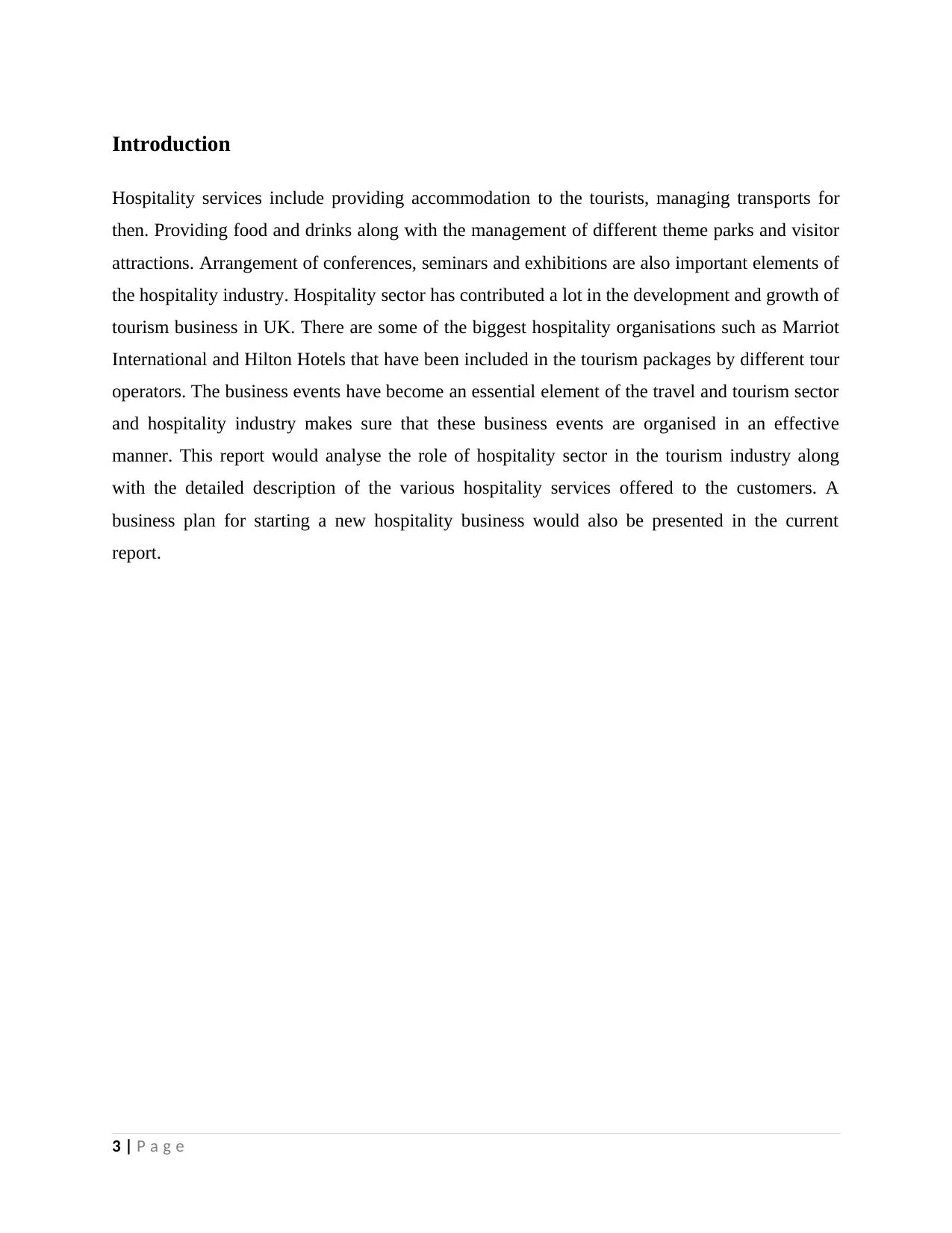
Introduction
Hospitality services include providing accommodation to the tourists, managing transports for
then. Providing food and drinks along with the management of different theme parks and visitor
attractions. Arrangement of conferences, seminars and exhibitions are also important elements of
the hospitality industry. Hospitality sector has contributed a lot in the development and growth of
tourism business in UK. There are some of the biggest hospitality organisations such as Marriot
International and Hilton Hotels that have been included in the tourism packages by different tour
operators. The business events have become an essential element of the travel and tourism sector
and hospitality industry makes sure that these business events are organised in an effective
manner. This report would analyse the role of hospitality sector in the tourism industry along
with the detailed description of the various hospitality services offered to the customers. A
business plan for starting a new hospitality business would also be presented in the current
report.
3 | P a g e
Hospitality services include providing accommodation to the tourists, managing transports for
then. Providing food and drinks along with the management of different theme parks and visitor
attractions. Arrangement of conferences, seminars and exhibitions are also important elements of
the hospitality industry. Hospitality sector has contributed a lot in the development and growth of
tourism business in UK. There are some of the biggest hospitality organisations such as Marriot
International and Hilton Hotels that have been included in the tourism packages by different tour
operators. The business events have become an essential element of the travel and tourism sector
and hospitality industry makes sure that these business events are organised in an effective
manner. This report would analyse the role of hospitality sector in the tourism industry along
with the detailed description of the various hospitality services offered to the customers. A
business plan for starting a new hospitality business would also be presented in the current
report.
3 | P a g e
⊘ This is a preview!⊘
Do you want full access?
Subscribe today to unlock all pages.

Trusted by 1+ million students worldwide
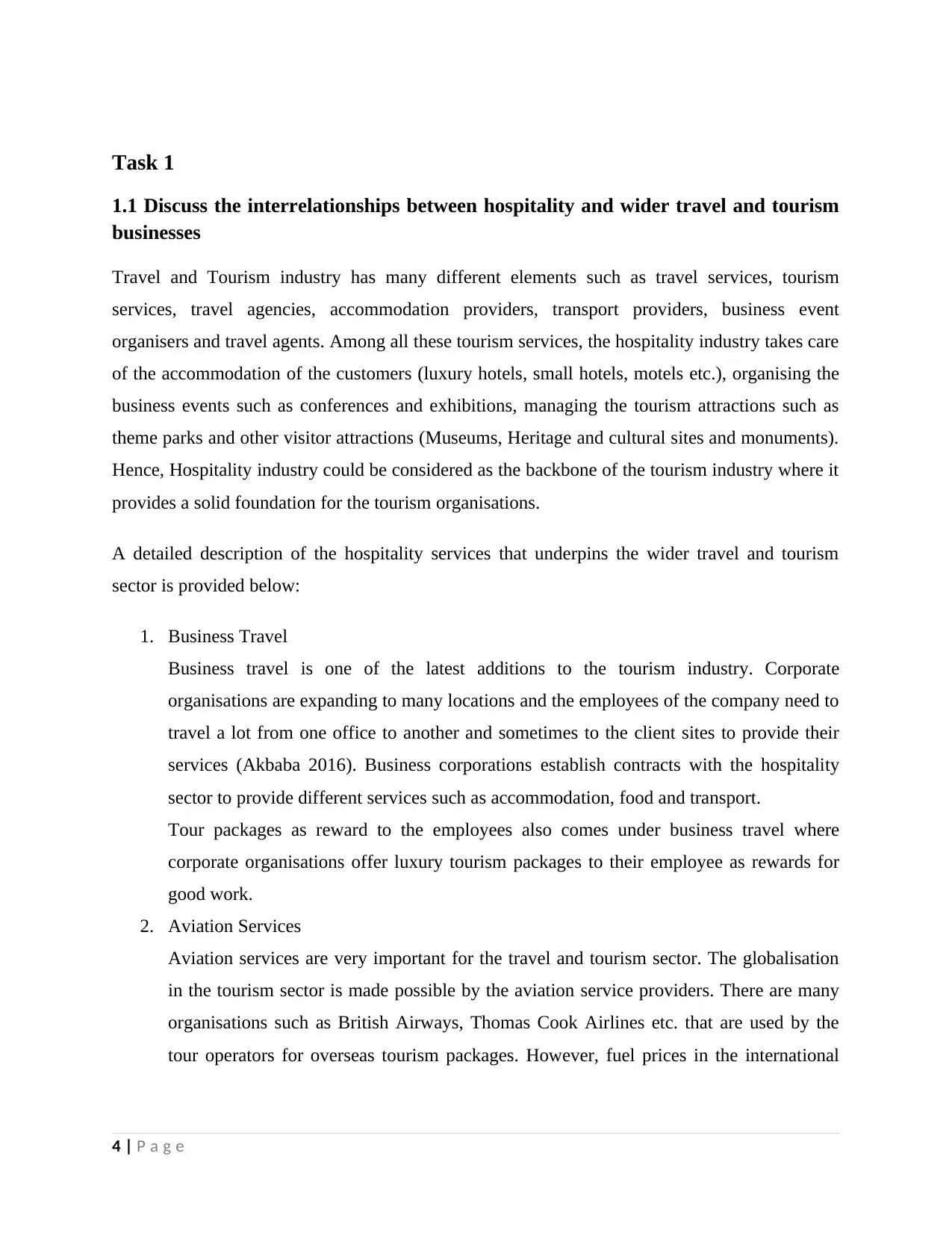
Task 1
1.1 Discuss the interrelationships between hospitality and wider travel and tourism
businesses
Travel and Tourism industry has many different elements such as travel services, tourism
services, travel agencies, accommodation providers, transport providers, business event
organisers and travel agents. Among all these tourism services, the hospitality industry takes care
of the accommodation of the customers (luxury hotels, small hotels, motels etc.), organising the
business events such as conferences and exhibitions, managing the tourism attractions such as
theme parks and other visitor attractions (Museums, Heritage and cultural sites and monuments).
Hence, Hospitality industry could be considered as the backbone of the tourism industry where it
provides a solid foundation for the tourism organisations.
A detailed description of the hospitality services that underpins the wider travel and tourism
sector is provided below:
1. Business Travel
Business travel is one of the latest additions to the tourism industry. Corporate
organisations are expanding to many locations and the employees of the company need to
travel a lot from one office to another and sometimes to the client sites to provide their
services (Akbaba 2016). Business corporations establish contracts with the hospitality
sector to provide different services such as accommodation, food and transport.
Tour packages as reward to the employees also comes under business travel where
corporate organisations offer luxury tourism packages to their employee as rewards for
good work.
2. Aviation Services
Aviation services are very important for the travel and tourism sector. The globalisation
in the tourism sector is made possible by the aviation service providers. There are many
organisations such as British Airways, Thomas Cook Airlines etc. that are used by the
tour operators for overseas tourism packages. However, fuel prices in the international
4 | P a g e
1.1 Discuss the interrelationships between hospitality and wider travel and tourism
businesses
Travel and Tourism industry has many different elements such as travel services, tourism
services, travel agencies, accommodation providers, transport providers, business event
organisers and travel agents. Among all these tourism services, the hospitality industry takes care
of the accommodation of the customers (luxury hotels, small hotels, motels etc.), organising the
business events such as conferences and exhibitions, managing the tourism attractions such as
theme parks and other visitor attractions (Museums, Heritage and cultural sites and monuments).
Hence, Hospitality industry could be considered as the backbone of the tourism industry where it
provides a solid foundation for the tourism organisations.
A detailed description of the hospitality services that underpins the wider travel and tourism
sector is provided below:
1. Business Travel
Business travel is one of the latest additions to the tourism industry. Corporate
organisations are expanding to many locations and the employees of the company need to
travel a lot from one office to another and sometimes to the client sites to provide their
services (Akbaba 2016). Business corporations establish contracts with the hospitality
sector to provide different services such as accommodation, food and transport.
Tour packages as reward to the employees also comes under business travel where
corporate organisations offer luxury tourism packages to their employee as rewards for
good work.
2. Aviation Services
Aviation services are very important for the travel and tourism sector. The globalisation
in the tourism sector is made possible by the aviation service providers. There are many
organisations such as British Airways, Thomas Cook Airlines etc. that are used by the
tour operators for overseas tourism packages. However, fuel prices in the international
4 | P a g e
Paraphrase This Document
Need a fresh take? Get an instant paraphrase of this document with our AI Paraphraser
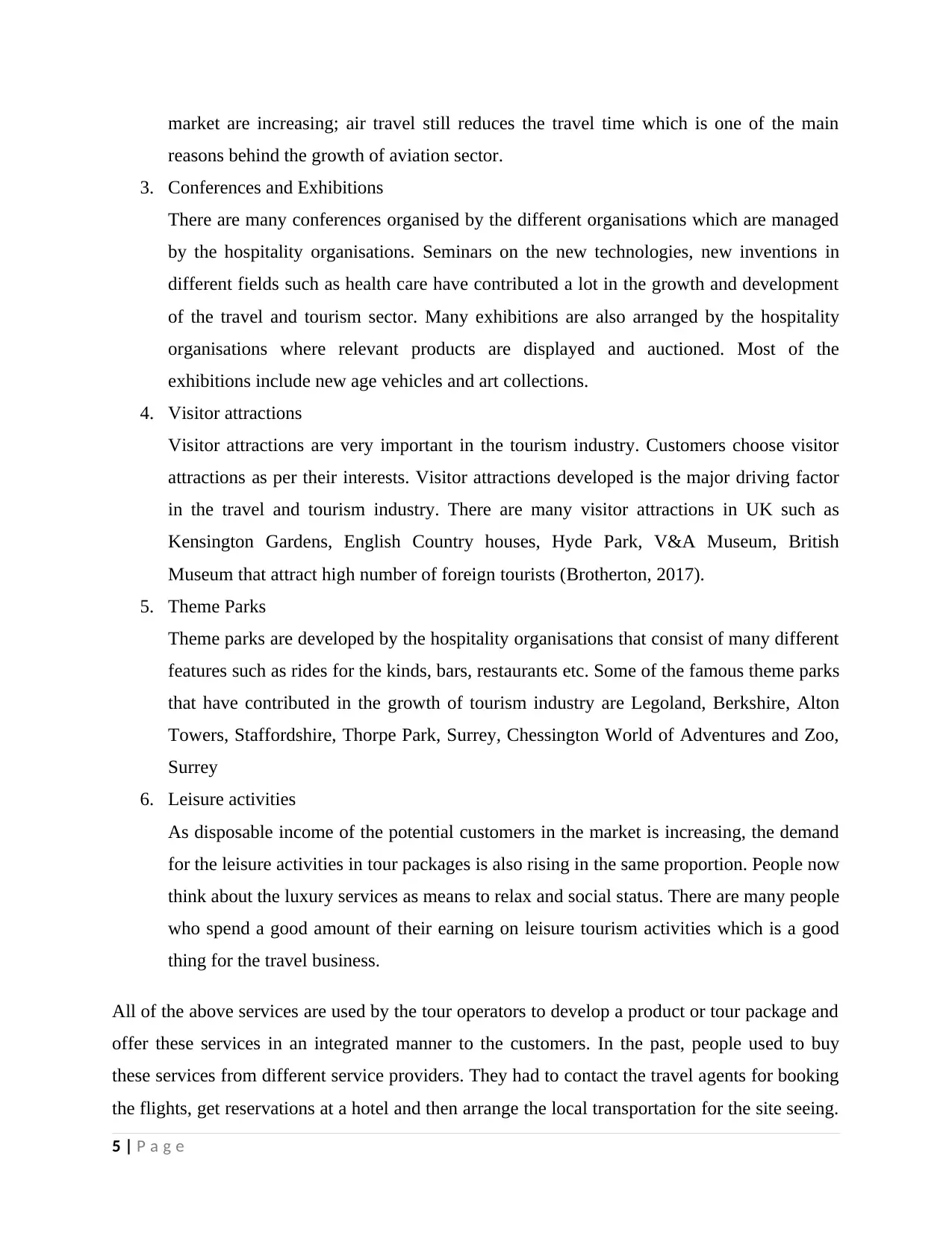
market are increasing; air travel still reduces the travel time which is one of the main
reasons behind the growth of aviation sector.
3. Conferences and Exhibitions
There are many conferences organised by the different organisations which are managed
by the hospitality organisations. Seminars on the new technologies, new inventions in
different fields such as health care have contributed a lot in the growth and development
of the travel and tourism sector. Many exhibitions are also arranged by the hospitality
organisations where relevant products are displayed and auctioned. Most of the
exhibitions include new age vehicles and art collections.
4. Visitor attractions
Visitor attractions are very important in the tourism industry. Customers choose visitor
attractions as per their interests. Visitor attractions developed is the major driving factor
in the travel and tourism industry. There are many visitor attractions in UK such as
Kensington Gardens, English Country houses, Hyde Park, V&A Museum, British
Museum that attract high number of foreign tourists (Brotherton, 2017).
5. Theme Parks
Theme parks are developed by the hospitality organisations that consist of many different
features such as rides for the kinds, bars, restaurants etc. Some of the famous theme parks
that have contributed in the growth of tourism industry are Legoland, Berkshire, Alton
Towers, Staffordshire, Thorpe Park, Surrey, Chessington World of Adventures and Zoo,
Surrey
6. Leisure activities
As disposable income of the potential customers in the market is increasing, the demand
for the leisure activities in tour packages is also rising in the same proportion. People now
think about the luxury services as means to relax and social status. There are many people
who spend a good amount of their earning on leisure tourism activities which is a good
thing for the travel business.
All of the above services are used by the tour operators to develop a product or tour package and
offer these services in an integrated manner to the customers. In the past, people used to buy
these services from different service providers. They had to contact the travel agents for booking
the flights, get reservations at a hotel and then arrange the local transportation for the site seeing.
5 | P a g e
reasons behind the growth of aviation sector.
3. Conferences and Exhibitions
There are many conferences organised by the different organisations which are managed
by the hospitality organisations. Seminars on the new technologies, new inventions in
different fields such as health care have contributed a lot in the growth and development
of the travel and tourism sector. Many exhibitions are also arranged by the hospitality
organisations where relevant products are displayed and auctioned. Most of the
exhibitions include new age vehicles and art collections.
4. Visitor attractions
Visitor attractions are very important in the tourism industry. Customers choose visitor
attractions as per their interests. Visitor attractions developed is the major driving factor
in the travel and tourism industry. There are many visitor attractions in UK such as
Kensington Gardens, English Country houses, Hyde Park, V&A Museum, British
Museum that attract high number of foreign tourists (Brotherton, 2017).
5. Theme Parks
Theme parks are developed by the hospitality organisations that consist of many different
features such as rides for the kinds, bars, restaurants etc. Some of the famous theme parks
that have contributed in the growth of tourism industry are Legoland, Berkshire, Alton
Towers, Staffordshire, Thorpe Park, Surrey, Chessington World of Adventures and Zoo,
Surrey
6. Leisure activities
As disposable income of the potential customers in the market is increasing, the demand
for the leisure activities in tour packages is also rising in the same proportion. People now
think about the luxury services as means to relax and social status. There are many people
who spend a good amount of their earning on leisure tourism activities which is a good
thing for the travel business.
All of the above services are used by the tour operators to develop a product or tour package and
offer these services in an integrated manner to the customers. In the past, people used to buy
these services from different service providers. They had to contact the travel agents for booking
the flights, get reservations at a hotel and then arrange the local transportation for the site seeing.
5 | P a g e
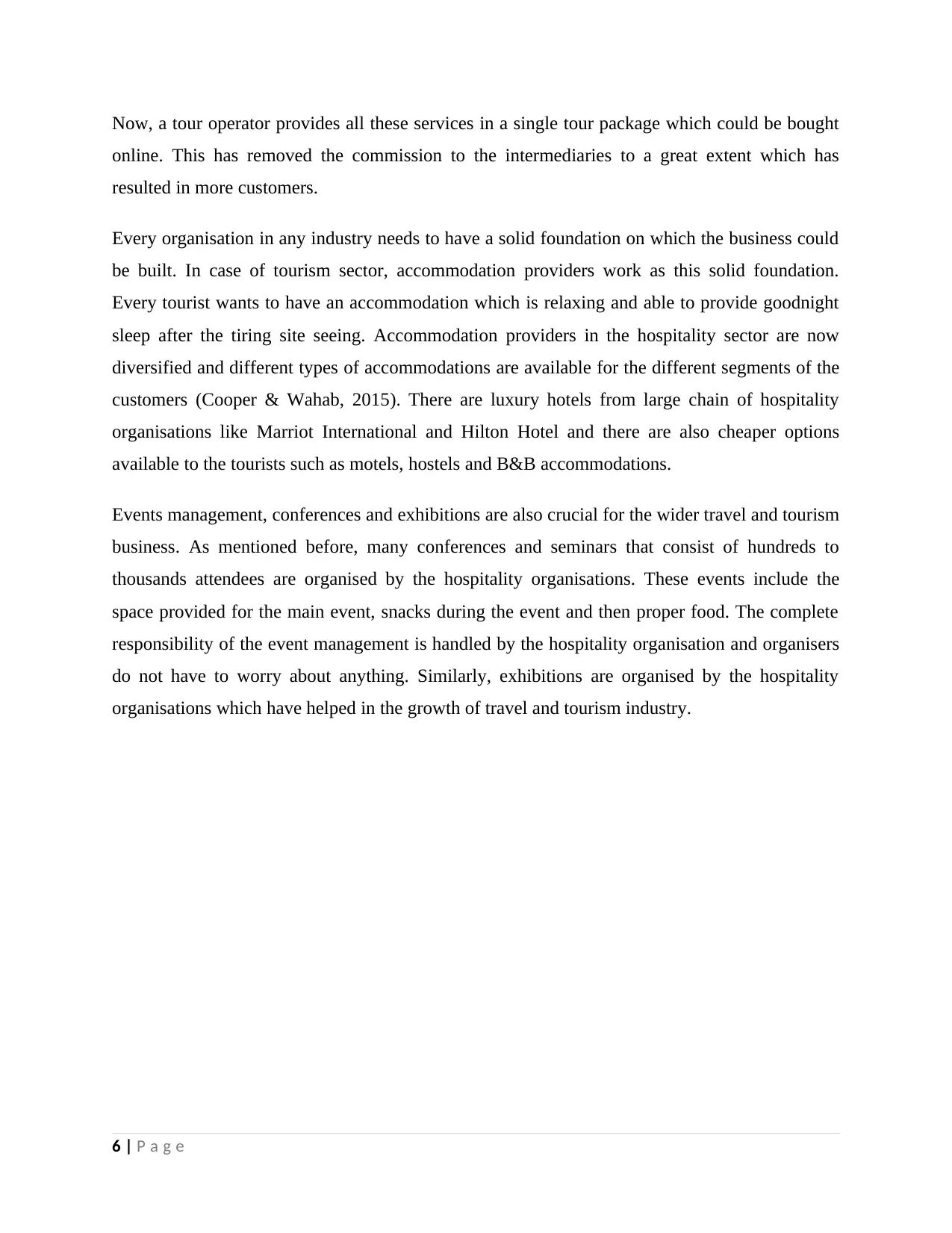
Now, a tour operator provides all these services in a single tour package which could be bought
online. This has removed the commission to the intermediaries to a great extent which has
resulted in more customers.
Every organisation in any industry needs to have a solid foundation on which the business could
be built. In case of tourism sector, accommodation providers work as this solid foundation.
Every tourist wants to have an accommodation which is relaxing and able to provide goodnight
sleep after the tiring site seeing. Accommodation providers in the hospitality sector are now
diversified and different types of accommodations are available for the different segments of the
customers (Cooper & Wahab, 2015). There are luxury hotels from large chain of hospitality
organisations like Marriot International and Hilton Hotel and there are also cheaper options
available to the tourists such as motels, hostels and B&B accommodations.
Events management, conferences and exhibitions are also crucial for the wider travel and tourism
business. As mentioned before, many conferences and seminars that consist of hundreds to
thousands attendees are organised by the hospitality organisations. These events include the
space provided for the main event, snacks during the event and then proper food. The complete
responsibility of the event management is handled by the hospitality organisation and organisers
do not have to worry about anything. Similarly, exhibitions are organised by the hospitality
organisations which have helped in the growth of travel and tourism industry.
6 | P a g e
online. This has removed the commission to the intermediaries to a great extent which has
resulted in more customers.
Every organisation in any industry needs to have a solid foundation on which the business could
be built. In case of tourism sector, accommodation providers work as this solid foundation.
Every tourist wants to have an accommodation which is relaxing and able to provide goodnight
sleep after the tiring site seeing. Accommodation providers in the hospitality sector are now
diversified and different types of accommodations are available for the different segments of the
customers (Cooper & Wahab, 2015). There are luxury hotels from large chain of hospitality
organisations like Marriot International and Hilton Hotel and there are also cheaper options
available to the tourists such as motels, hostels and B&B accommodations.
Events management, conferences and exhibitions are also crucial for the wider travel and tourism
business. As mentioned before, many conferences and seminars that consist of hundreds to
thousands attendees are organised by the hospitality organisations. These events include the
space provided for the main event, snacks during the event and then proper food. The complete
responsibility of the event management is handled by the hospitality organisation and organisers
do not have to worry about anything. Similarly, exhibitions are organised by the hospitality
organisations which have helped in the growth of travel and tourism industry.
6 | P a g e
⊘ This is a preview!⊘
Do you want full access?
Subscribe today to unlock all pages.

Trusted by 1+ million students worldwide
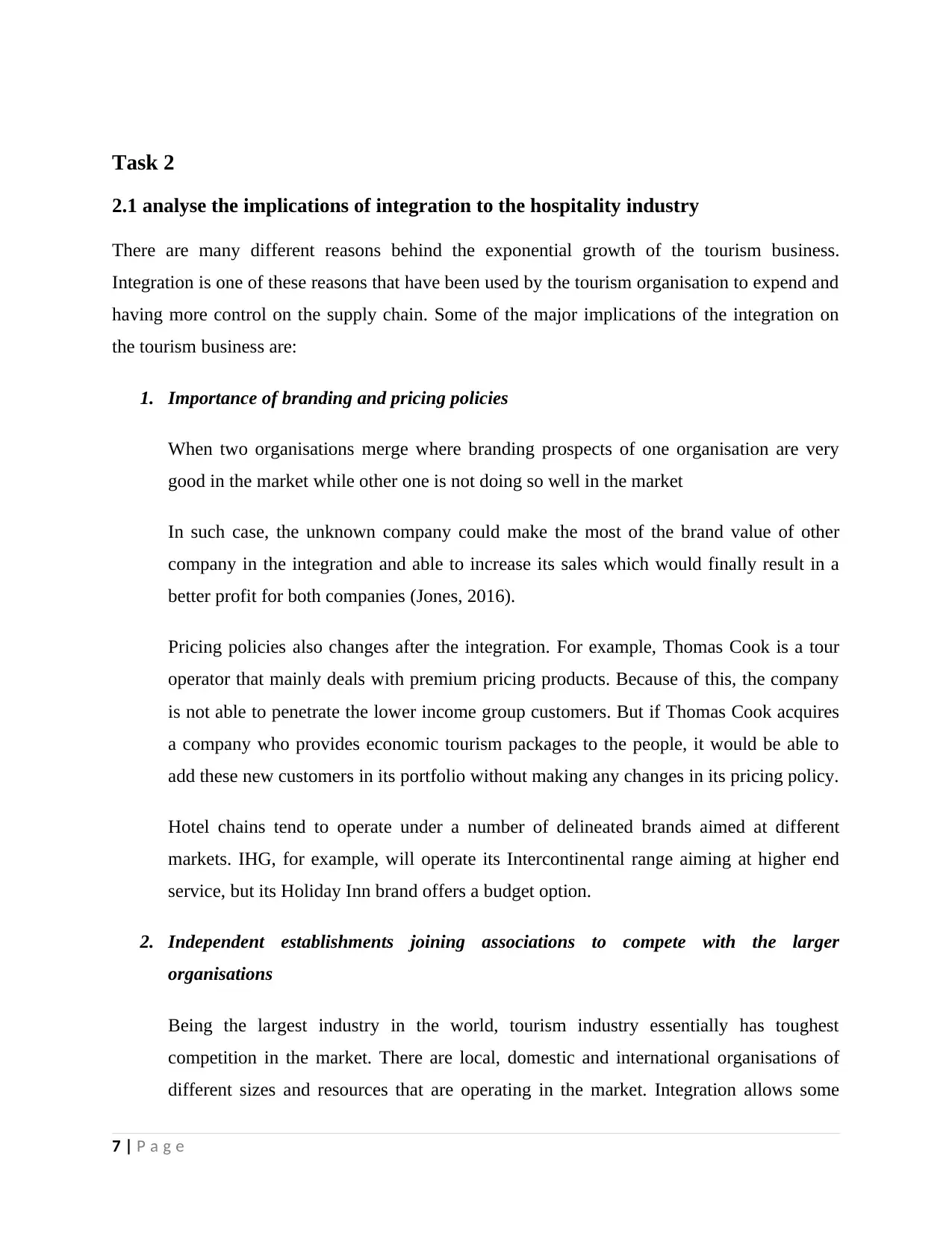
Task 2
2.1 analyse the implications of integration to the hospitality industry
There are many different reasons behind the exponential growth of the tourism business.
Integration is one of these reasons that have been used by the tourism organisation to expend and
having more control on the supply chain. Some of the major implications of the integration on
the tourism business are:
1. Importance of branding and pricing policies
When two organisations merge where branding prospects of one organisation are very
good in the market while other one is not doing so well in the market
In such case, the unknown company could make the most of the brand value of other
company in the integration and able to increase its sales which would finally result in a
better profit for both companies (Jones, 2016).
Pricing policies also changes after the integration. For example, Thomas Cook is a tour
operator that mainly deals with premium pricing products. Because of this, the company
is not able to penetrate the lower income group customers. But if Thomas Cook acquires
a company who provides economic tourism packages to the people, it would be able to
add these new customers in its portfolio without making any changes in its pricing policy.
Hotel chains tend to operate under a number of delineated brands aimed at different
markets. IHG, for example, will operate its Intercontinental range aiming at higher end
service, but its Holiday Inn brand offers a budget option.
2. Independent establishments joining associations to compete with the larger
organisations
Being the largest industry in the world, tourism industry essentially has toughest
competition in the market. There are local, domestic and international organisations of
different sizes and resources that are operating in the market. Integration allows some
7 | P a g e
2.1 analyse the implications of integration to the hospitality industry
There are many different reasons behind the exponential growth of the tourism business.
Integration is one of these reasons that have been used by the tourism organisation to expend and
having more control on the supply chain. Some of the major implications of the integration on
the tourism business are:
1. Importance of branding and pricing policies
When two organisations merge where branding prospects of one organisation are very
good in the market while other one is not doing so well in the market
In such case, the unknown company could make the most of the brand value of other
company in the integration and able to increase its sales which would finally result in a
better profit for both companies (Jones, 2016).
Pricing policies also changes after the integration. For example, Thomas Cook is a tour
operator that mainly deals with premium pricing products. Because of this, the company
is not able to penetrate the lower income group customers. But if Thomas Cook acquires
a company who provides economic tourism packages to the people, it would be able to
add these new customers in its portfolio without making any changes in its pricing policy.
Hotel chains tend to operate under a number of delineated brands aimed at different
markets. IHG, for example, will operate its Intercontinental range aiming at higher end
service, but its Holiday Inn brand offers a budget option.
2. Independent establishments joining associations to compete with the larger
organisations
Being the largest industry in the world, tourism industry essentially has toughest
competition in the market. There are local, domestic and international organisations of
different sizes and resources that are operating in the market. Integration allows some
7 | P a g e
Paraphrase This Document
Need a fresh take? Get an instant paraphrase of this document with our AI Paraphraser
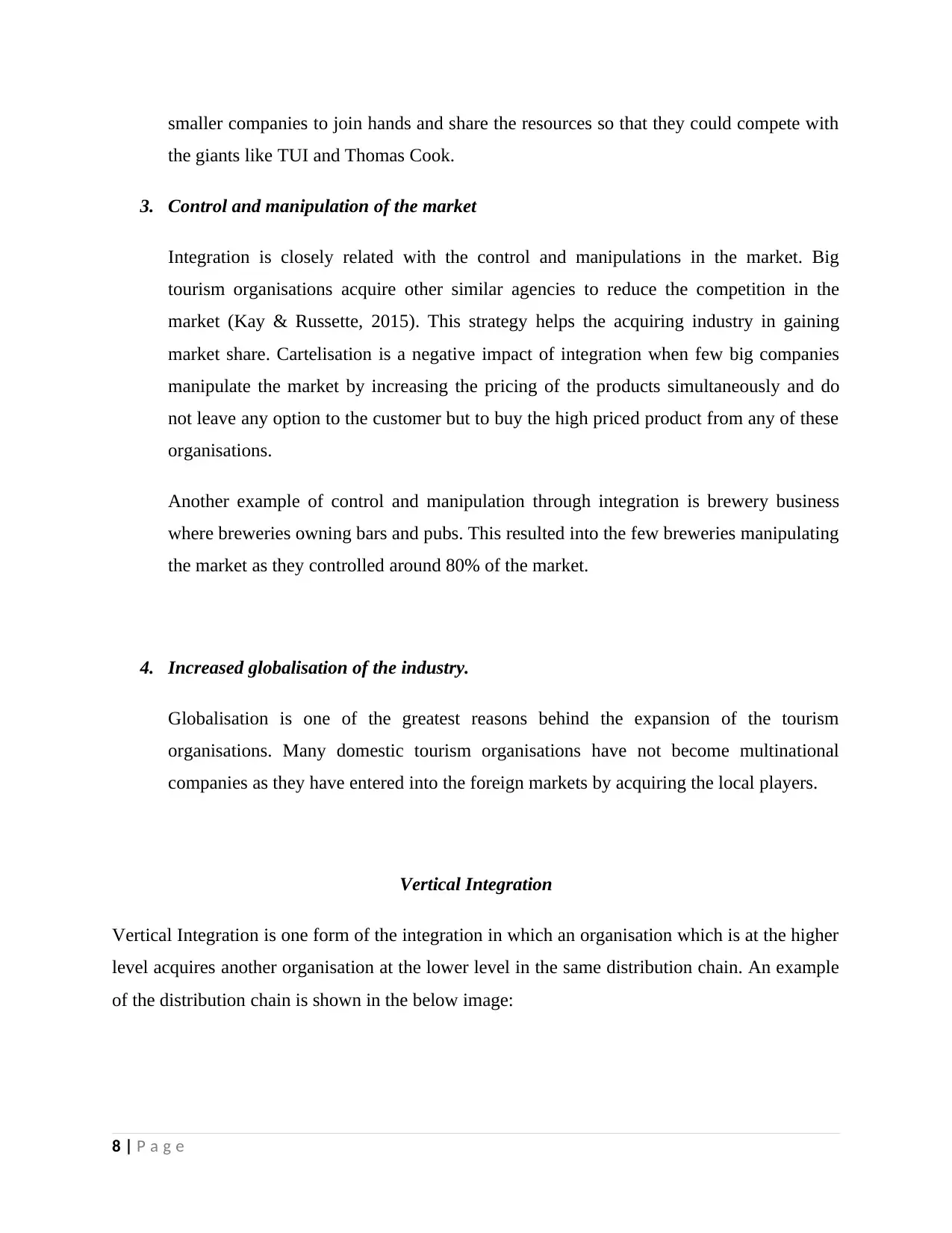
smaller companies to join hands and share the resources so that they could compete with
the giants like TUI and Thomas Cook.
3. Control and manipulation of the market
Integration is closely related with the control and manipulations in the market. Big
tourism organisations acquire other similar agencies to reduce the competition in the
market (Kay & Russette, 2015). This strategy helps the acquiring industry in gaining
market share. Cartelisation is a negative impact of integration when few big companies
manipulate the market by increasing the pricing of the products simultaneously and do
not leave any option to the customer but to buy the high priced product from any of these
organisations.
Another example of control and manipulation through integration is brewery business
where breweries owning bars and pubs. This resulted into the few breweries manipulating
the market as they controlled around 80% of the market.
4. Increased globalisation of the industry.
Globalisation is one of the greatest reasons behind the expansion of the tourism
organisations. Many domestic tourism organisations have not become multinational
companies as they have entered into the foreign markets by acquiring the local players.
Vertical Integration
Vertical Integration is one form of the integration in which an organisation which is at the higher
level acquires another organisation at the lower level in the same distribution chain. An example
of the distribution chain is shown in the below image:
8 | P a g e
the giants like TUI and Thomas Cook.
3. Control and manipulation of the market
Integration is closely related with the control and manipulations in the market. Big
tourism organisations acquire other similar agencies to reduce the competition in the
market (Kay & Russette, 2015). This strategy helps the acquiring industry in gaining
market share. Cartelisation is a negative impact of integration when few big companies
manipulate the market by increasing the pricing of the products simultaneously and do
not leave any option to the customer but to buy the high priced product from any of these
organisations.
Another example of control and manipulation through integration is brewery business
where breweries owning bars and pubs. This resulted into the few breweries manipulating
the market as they controlled around 80% of the market.
4. Increased globalisation of the industry.
Globalisation is one of the greatest reasons behind the expansion of the tourism
organisations. Many domestic tourism organisations have not become multinational
companies as they have entered into the foreign markets by acquiring the local players.
Vertical Integration
Vertical Integration is one form of the integration in which an organisation which is at the higher
level acquires another organisation at the lower level in the same distribution chain. An example
of the distribution chain is shown in the below image:
8 | P a g e
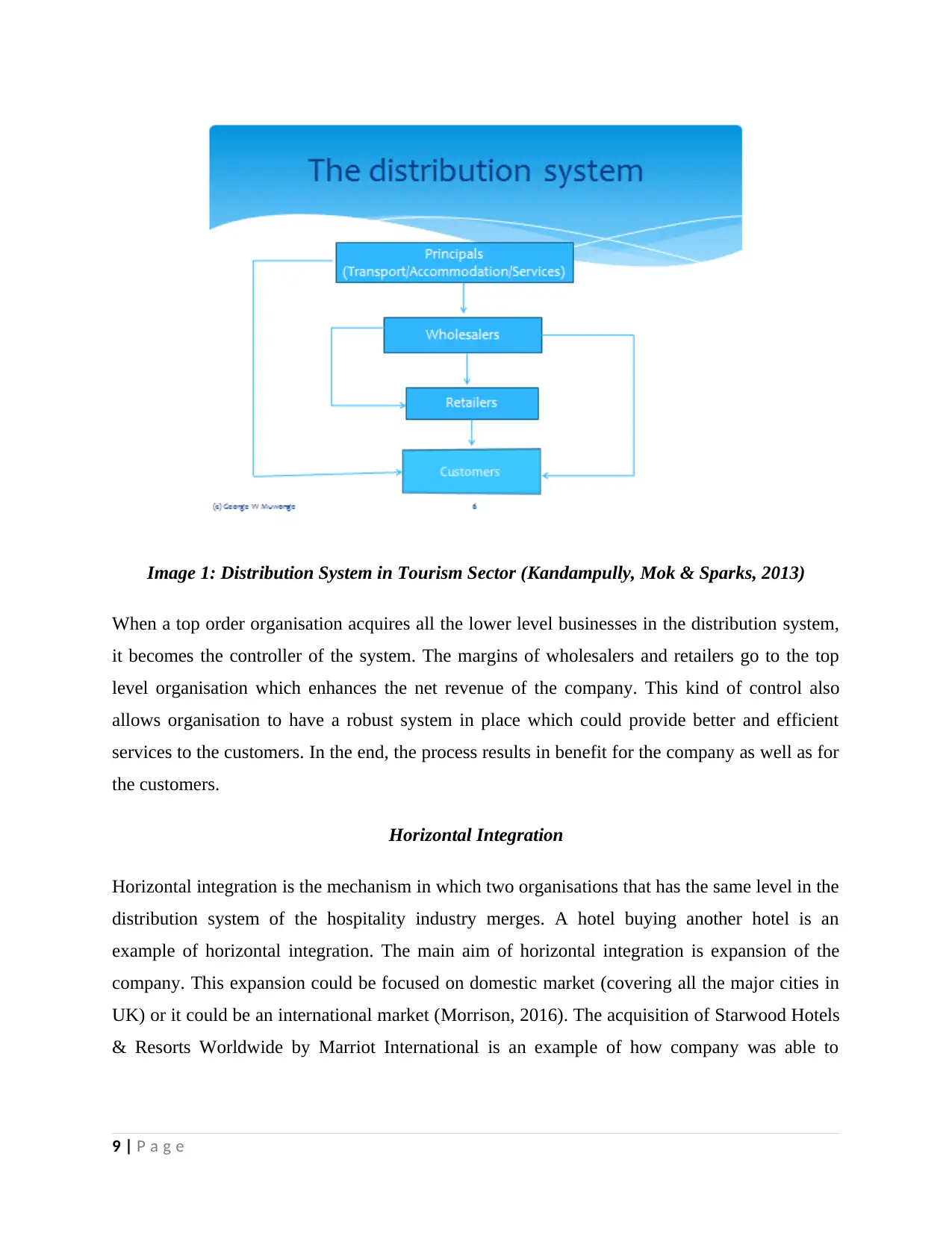
Image 1: Distribution System in Tourism Sector (Kandampully, Mok & Sparks, 2013)
When a top order organisation acquires all the lower level businesses in the distribution system,
it becomes the controller of the system. The margins of wholesalers and retailers go to the top
level organisation which enhances the net revenue of the company. This kind of control also
allows organisation to have a robust system in place which could provide better and efficient
services to the customers. In the end, the process results in benefit for the company as well as for
the customers.
Horizontal Integration
Horizontal integration is the mechanism in which two organisations that has the same level in the
distribution system of the hospitality industry merges. A hotel buying another hotel is an
example of horizontal integration. The main aim of horizontal integration is expansion of the
company. This expansion could be focused on domestic market (covering all the major cities in
UK) or it could be an international market (Morrison, 2016). The acquisition of Starwood Hotels
& Resorts Worldwide by Marriot International is an example of how company was able to
9 | P a g e
When a top order organisation acquires all the lower level businesses in the distribution system,
it becomes the controller of the system. The margins of wholesalers and retailers go to the top
level organisation which enhances the net revenue of the company. This kind of control also
allows organisation to have a robust system in place which could provide better and efficient
services to the customers. In the end, the process results in benefit for the company as well as for
the customers.
Horizontal Integration
Horizontal integration is the mechanism in which two organisations that has the same level in the
distribution system of the hospitality industry merges. A hotel buying another hotel is an
example of horizontal integration. The main aim of horizontal integration is expansion of the
company. This expansion could be focused on domestic market (covering all the major cities in
UK) or it could be an international market (Morrison, 2016). The acquisition of Starwood Hotels
& Resorts Worldwide by Marriot International is an example of how company was able to
9 | P a g e
⊘ This is a preview!⊘
Do you want full access?
Subscribe today to unlock all pages.

Trusted by 1+ million students worldwide
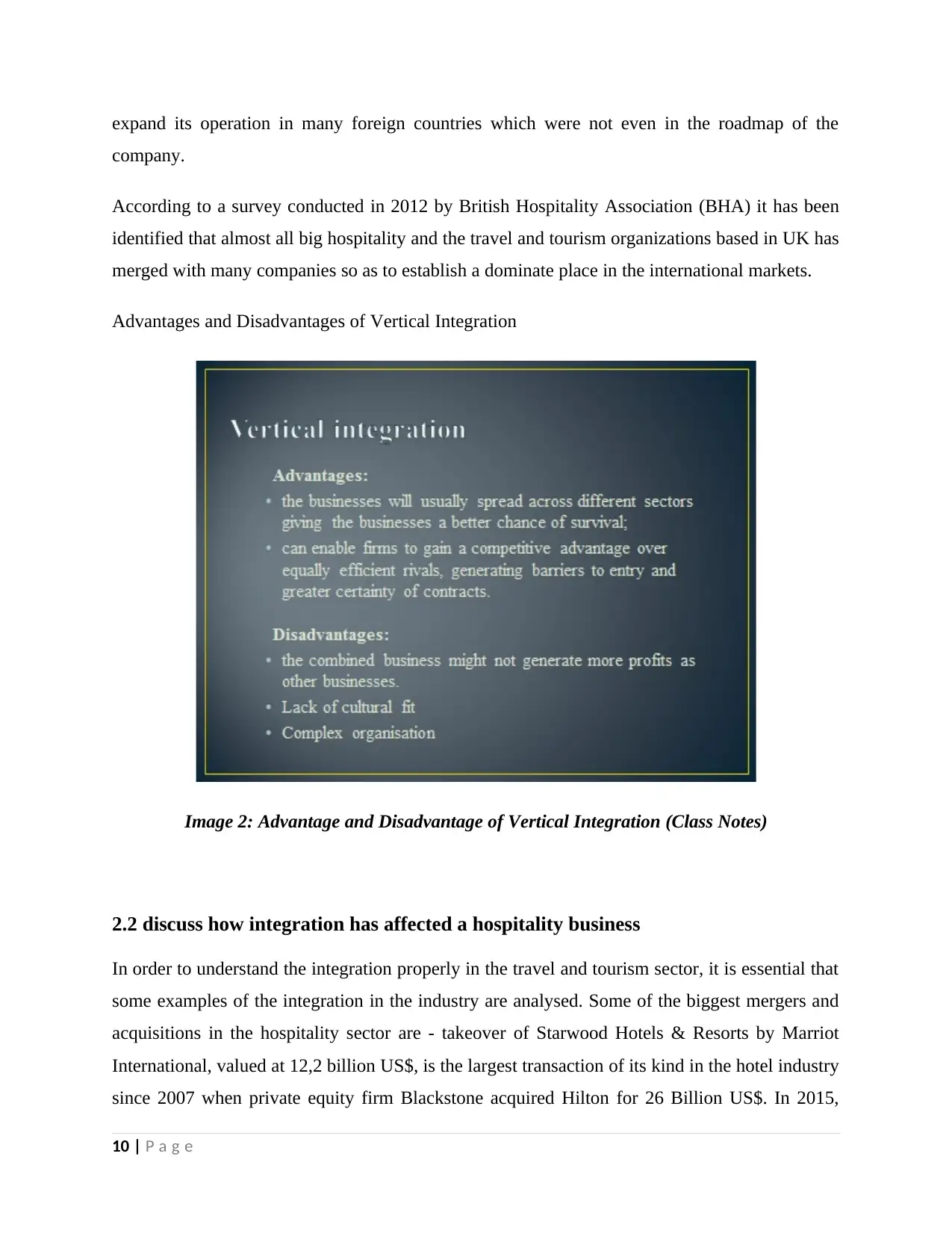
expand its operation in many foreign countries which were not even in the roadmap of the
company.
According to a survey conducted in 2012 by British Hospitality Association (BHA) it has been
identified that almost all big hospitality and the travel and tourism organizations based in UK has
merged with many companies so as to establish a dominate place in the international markets.
Advantages and Disadvantages of Vertical Integration
Image 2: Advantage and Disadvantage of Vertical Integration (Class Notes)
2.2 discuss how integration has affected a hospitality business
In order to understand the integration properly in the travel and tourism sector, it is essential that
some examples of the integration in the industry are analysed. Some of the biggest mergers and
acquisitions in the hospitality sector are - takeover of Starwood Hotels & Resorts by Marriot
International, valued at 12,2 billion US$, is the largest transaction of its kind in the hotel industry
since 2007 when private equity firm Blackstone acquired Hilton for 26 Billion US$. In 2015,
10 | P a g e
company.
According to a survey conducted in 2012 by British Hospitality Association (BHA) it has been
identified that almost all big hospitality and the travel and tourism organizations based in UK has
merged with many companies so as to establish a dominate place in the international markets.
Advantages and Disadvantages of Vertical Integration
Image 2: Advantage and Disadvantage of Vertical Integration (Class Notes)
2.2 discuss how integration has affected a hospitality business
In order to understand the integration properly in the travel and tourism sector, it is essential that
some examples of the integration in the industry are analysed. Some of the biggest mergers and
acquisitions in the hospitality sector are - takeover of Starwood Hotels & Resorts by Marriot
International, valued at 12,2 billion US$, is the largest transaction of its kind in the hotel industry
since 2007 when private equity firm Blackstone acquired Hilton for 26 Billion US$. In 2015,
10 | P a g e
Paraphrase This Document
Need a fresh take? Get an instant paraphrase of this document with our AI Paraphraser
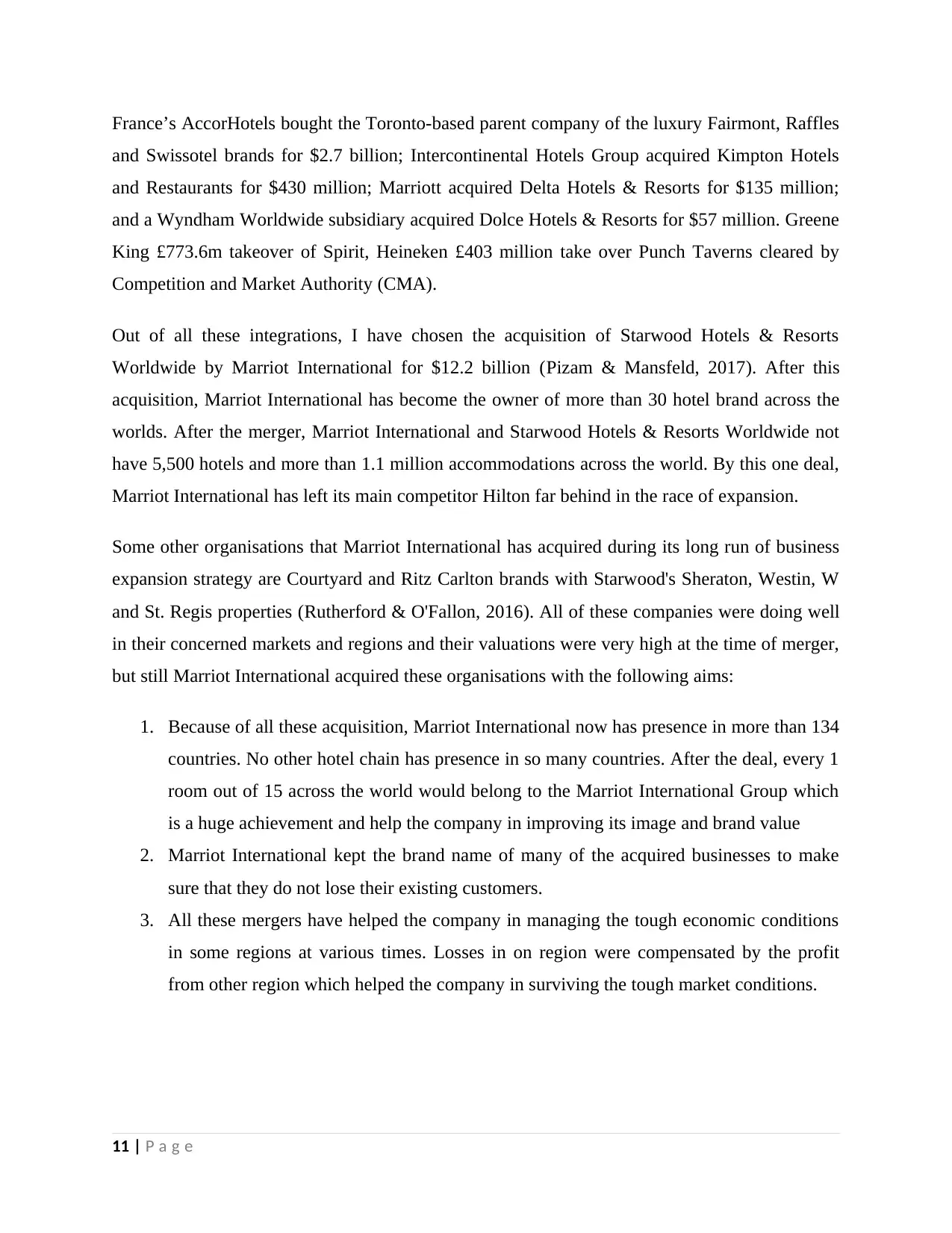
France’s AccorHotels bought the Toronto-based parent company of the luxury Fairmont, Raffles
and Swissotel brands for $2.7 billion; Intercontinental Hotels Group acquired Kimpton Hotels
and Restaurants for $430 million; Marriott acquired Delta Hotels & Resorts for $135 million;
and a Wyndham Worldwide subsidiary acquired Dolce Hotels & Resorts for $57 million. Greene
King £773.6m takeover of Spirit, Heineken £403 million take over Punch Taverns cleared by
Competition and Market Authority (CMA).
Out of all these integrations, I have chosen the acquisition of Starwood Hotels & Resorts
Worldwide by Marriot International for $12.2 billion (Pizam & Mansfeld, 2017). After this
acquisition, Marriot International has become the owner of more than 30 hotel brand across the
worlds. After the merger, Marriot International and Starwood Hotels & Resorts Worldwide not
have 5,500 hotels and more than 1.1 million accommodations across the world. By this one deal,
Marriot International has left its main competitor Hilton far behind in the race of expansion.
Some other organisations that Marriot International has acquired during its long run of business
expansion strategy are Courtyard and Ritz Carlton brands with Starwood's Sheraton, Westin, W
and St. Regis properties (Rutherford & O'Fallon, 2016). All of these companies were doing well
in their concerned markets and regions and their valuations were very high at the time of merger,
but still Marriot International acquired these organisations with the following aims:
1. Because of all these acquisition, Marriot International now has presence in more than 134
countries. No other hotel chain has presence in so many countries. After the deal, every 1
room out of 15 across the world would belong to the Marriot International Group which
is a huge achievement and help the company in improving its image and brand value
2. Marriot International kept the brand name of many of the acquired businesses to make
sure that they do not lose their existing customers.
3. All these mergers have helped the company in managing the tough economic conditions
in some regions at various times. Losses in on region were compensated by the profit
from other region which helped the company in surviving the tough market conditions.
11 | P a g e
and Swissotel brands for $2.7 billion; Intercontinental Hotels Group acquired Kimpton Hotels
and Restaurants for $430 million; Marriott acquired Delta Hotels & Resorts for $135 million;
and a Wyndham Worldwide subsidiary acquired Dolce Hotels & Resorts for $57 million. Greene
King £773.6m takeover of Spirit, Heineken £403 million take over Punch Taverns cleared by
Competition and Market Authority (CMA).
Out of all these integrations, I have chosen the acquisition of Starwood Hotels & Resorts
Worldwide by Marriot International for $12.2 billion (Pizam & Mansfeld, 2017). After this
acquisition, Marriot International has become the owner of more than 30 hotel brand across the
worlds. After the merger, Marriot International and Starwood Hotels & Resorts Worldwide not
have 5,500 hotels and more than 1.1 million accommodations across the world. By this one deal,
Marriot International has left its main competitor Hilton far behind in the race of expansion.
Some other organisations that Marriot International has acquired during its long run of business
expansion strategy are Courtyard and Ritz Carlton brands with Starwood's Sheraton, Westin, W
and St. Regis properties (Rutherford & O'Fallon, 2016). All of these companies were doing well
in their concerned markets and regions and their valuations were very high at the time of merger,
but still Marriot International acquired these organisations with the following aims:
1. Because of all these acquisition, Marriot International now has presence in more than 134
countries. No other hotel chain has presence in so many countries. After the deal, every 1
room out of 15 across the world would belong to the Marriot International Group which
is a huge achievement and help the company in improving its image and brand value
2. Marriot International kept the brand name of many of the acquired businesses to make
sure that they do not lose their existing customers.
3. All these mergers have helped the company in managing the tough economic conditions
in some regions at various times. Losses in on region were compensated by the profit
from other region which helped the company in surviving the tough market conditions.
11 | P a g e
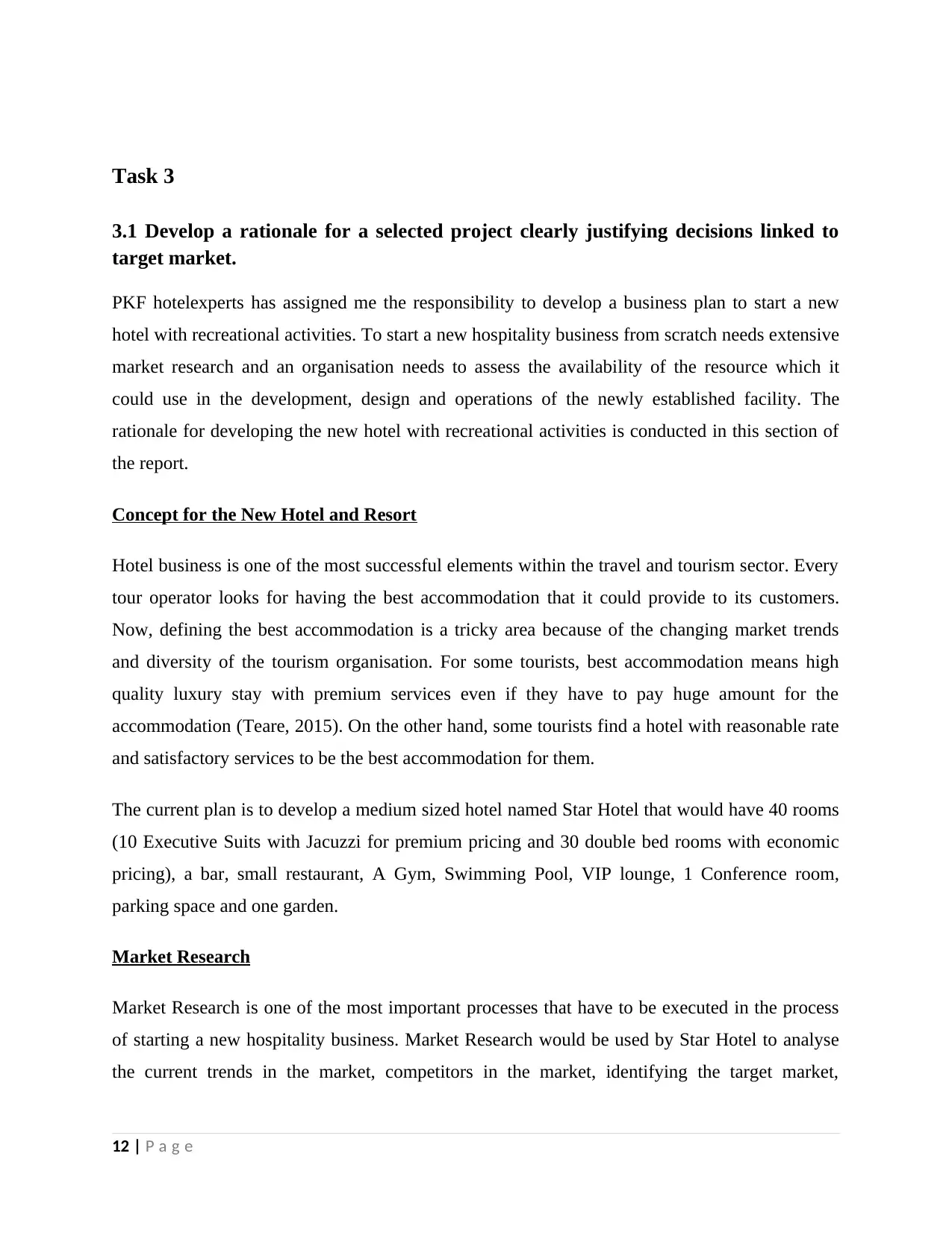
Task 3
3.1 Develop a rationale for a selected project clearly justifying decisions linked to
target market.
PKF hotelexperts has assigned me the responsibility to develop a business plan to start a new
hotel with recreational activities. To start a new hospitality business from scratch needs extensive
market research and an organisation needs to assess the availability of the resource which it
could use in the development, design and operations of the newly established facility. The
rationale for developing the new hotel with recreational activities is conducted in this section of
the report.
Concept for the New Hotel and Resort
Hotel business is one of the most successful elements within the travel and tourism sector. Every
tour operator looks for having the best accommodation that it could provide to its customers.
Now, defining the best accommodation is a tricky area because of the changing market trends
and diversity of the tourism organisation. For some tourists, best accommodation means high
quality luxury stay with premium services even if they have to pay huge amount for the
accommodation (Teare, 2015). On the other hand, some tourists find a hotel with reasonable rate
and satisfactory services to be the best accommodation for them.
The current plan is to develop a medium sized hotel named Star Hotel that would have 40 rooms
(10 Executive Suits with Jacuzzi for premium pricing and 30 double bed rooms with economic
pricing), a bar, small restaurant, A Gym, Swimming Pool, VIP lounge, 1 Conference room,
parking space and one garden.
Market Research
Market Research is one of the most important processes that have to be executed in the process
of starting a new hospitality business. Market Research would be used by Star Hotel to analyse
the current trends in the market, competitors in the market, identifying the target market,
12 | P a g e
3.1 Develop a rationale for a selected project clearly justifying decisions linked to
target market.
PKF hotelexperts has assigned me the responsibility to develop a business plan to start a new
hotel with recreational activities. To start a new hospitality business from scratch needs extensive
market research and an organisation needs to assess the availability of the resource which it
could use in the development, design and operations of the newly established facility. The
rationale for developing the new hotel with recreational activities is conducted in this section of
the report.
Concept for the New Hotel and Resort
Hotel business is one of the most successful elements within the travel and tourism sector. Every
tour operator looks for having the best accommodation that it could provide to its customers.
Now, defining the best accommodation is a tricky area because of the changing market trends
and diversity of the tourism organisation. For some tourists, best accommodation means high
quality luxury stay with premium services even if they have to pay huge amount for the
accommodation (Teare, 2015). On the other hand, some tourists find a hotel with reasonable rate
and satisfactory services to be the best accommodation for them.
The current plan is to develop a medium sized hotel named Star Hotel that would have 40 rooms
(10 Executive Suits with Jacuzzi for premium pricing and 30 double bed rooms with economic
pricing), a bar, small restaurant, A Gym, Swimming Pool, VIP lounge, 1 Conference room,
parking space and one garden.
Market Research
Market Research is one of the most important processes that have to be executed in the process
of starting a new hospitality business. Market Research would be used by Star Hotel to analyse
the current trends in the market, competitors in the market, identifying the target market,
12 | P a g e
⊘ This is a preview!⊘
Do you want full access?
Subscribe today to unlock all pages.

Trusted by 1+ million students worldwide
1 out of 19
Related Documents
Your All-in-One AI-Powered Toolkit for Academic Success.
+13062052269
info@desklib.com
Available 24*7 on WhatsApp / Email
![[object Object]](/_next/static/media/star-bottom.7253800d.svg)
Unlock your academic potential
Copyright © 2020–2025 A2Z Services. All Rights Reserved. Developed and managed by ZUCOL.





